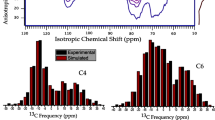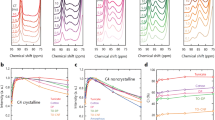Abstract
How nuclear spin dynamics of a polysaccharide are influenced by its anionic side chain is studied by measuring the chemical shift anisotropy (CSA) tensor and site-specific spin–lattice relaxation time of xanthan, compared with those values for cellulose. The cellulose backbone of xanthan is substituted on every other \(\beta \)-d-glucose residue with an anionic trisaccharide side chain. These studies show that the spin–lattice relaxation rate of carbon nuclei of xanthan is increased compared to cellulose. The local correlation time of carbon nuclei of xanthan is faster than cellulose. In a nutshell, the motional-dynamic of xanthan is increased compared to cellulose. The presence of anionic side chains enhances the hydration and solubility of xanthan compared to cellulose. Hence, the microscopic phenomenon, increase in spin–lattice relaxation rate, is correlated with the macroscopic feature, enhancement of solubility. Hence, the correlation between the macroscopic and microscopic characteristics of a polysaccharide is drawn by solid-state NMR measurements. The comparative description of the structure–activity relationship of linear polysaccharide (glucose) and anionic exopolysaccharide (xanthan), which are greatly different in terms of solubility, will help with inventing new biomimetic materials, which has huge application in pharmaceutical industries and tissue engineering. Additionally, the information about the local electronic environment and nuclear spin dynamics at crystallographically different carbon nuclei sides of polysaccharides by CSA measurements and spin–lattice relaxation time measurements will enrich the field ‘NMR-crystallography’.
Graphical abstract




Similar content being viewed by others
References
Ando I, Asakura T (eds) (1998) Solid state NMR of polymers. Elsevier Science, Amsterdam
Anet FAL, O’Leary DJ (1992) The shielding tensor Part II: Understanding its strange effect on relaxation. Concepts Magn Reson 4:35–52. https://doi.org/10.1002/cmr.1820040103
Antzutkin ON, Duer MJ, (eds) (2002) Solid-state nmr spectroscopy: principles and applications. Blackwell Sciences, Oxford, p 280
Antzutkin ON, Shekar SC, Levitt MH (1995) Two-dimensional sideband separation in magic angle spinning NMR. J. Magn. Reson. Ser A 115:7–19. https://doi.org/10.1006/jmra.1995.1142
Ashtaputre AA, Shah AK (1995) Studies on a viscous, gel-forming exopolysaccharide from Sphingomonaspaucimobilis GS1. Appl Environ Microbiol 61:1159–1162. https://doi.org/10.1128/aem.61.3.1159-1162.1995
Bax AD, Szeverenyi NM, Maciel GE (1983a) Correlation of isotropic shifts and chemical shift anisotropies by two-dimensional Fourier-transform magic angle hopping NMR spectroscopy. J Magn Reson 52:147–152. https://doi.org/10.1016/0022-2364(83)90267-6
Bax AD, Szeverenyi NM, Maciel GE (1983b) Chemical shift anisotropy in powdered solids studied by 2D FT CP/MAS NMR. J Magn Reson 51:400–408. https://doi.org/10.1016/0022-2364(83)90292-5
Bax AD, Szeverenyi NM, Maciel GE (1983c) Chemical shift anisotropy in powdered solids studied by 2D FT NMR with flipping of the spinning axis. J Magn Reson 55:494–497. https://doi.org/10.1016/0022-2364(83)90134-8
Bhowal R, Balaraman AA, Ghosh M, Dutta S, Dey KK, Chopra D (2021) Probing atomistic behaviour to unravel dielectric phenomena in charge transfer cocrystal. J Am Chem Soc 143:1024–1037. https://doi.org/10.1021/jacs.0c11459
Chan JCC, Tycko R (2003) Recoupling of chemical shift anisotropies in solid state NMR under high speed magic angle spinning and in uniformly 13C labelled systems. J Chem Phys 118:8378–8389. https://doi.org/10.1063/1.1565109
Dais P, Spyros A (1995) 13C nuclear magnetic relaxation and local dynamics of synthetic polymers in dilute solution and in the bulk state. Prog Nucl Magn Reson Spectrosc 27:555–633. https://doi.org/10.1016/0079-6565(95)01014-9
Dey KK, Gayen S, Ghosh M (2019a) Investigation of the detailed internal structure and dynamics of itraconazole by solid-state NMR measurements. ACS Omega 4:21627–21635. https://doi.org/10.1021/acsomega.9b03558
Dey KK, Gayen S, Ghosh M (2019b) Understanding the correlation between structure and dynamics of clocortolone pivalate by solid state NMR measurement. RSC Adv 10:4310–4321. https://doi.org/10.1039/c9ra09866f
Dey KK, Ghosh M (2020a) Understanding the effect of deacetylation on chitin by measuring chemical shift anisotropy tensor and spin lattice relaxation time. Chem Phys Lett 738:136782. https://doi.org/10.1016/j.cplett.2019.136782
Dey KK, Ghosh M (2020b) Determination of the correlation between the structure and dynamics of deflazacort by solid state NMR measurements. New J Chem 44:18419–18430. https://doi.org/10.1039/d0nj03418e
Dey KK, Ghosh M (2020c) Understanding the structure and dynamics of anti-inflammatory corticosteroid dexamethasone by solid state NMR spectroscopy. RSC Adv 10:37564. https://doi.org/10.1039/d0ra05474g
Dey KK, Ghosh M (2020d) Determination of chemical shift anisotropy tensor and molecular correlation time of proton pump inhibitor omeprazole by solid State NMR measurements. New J Chem 44:19393–19403. https://doi.org/10.1039/d0nj01827a
Dey KK, Ghosh M (2020e) Investigation of the structure and dynamics of antiviral drug adefovir dipivoxil by site-specific spin–lattice relaxation time measurements and chemical shift anisotropy tensor measurements. ACS Omega 5:29373–29381. https://doi.org/10.1021/acsomega.0c04205
Dixon WT (1982) Spinning-sideband-free and spinning-sideband-only NMR spectra in spinning samples. J Chem Phys 77:1800–1809. https://doi.org/10.1063/1.444076
Duer MJ (2007) Solid state NMR spectroscopy principles and applications. Blackwell Science, Hoboken
Faria S, Petkowicz CLO, de Morais SAL, Terrones MGH, Resende MM, Franc FP, Cardoso VL (2011) Characterization of xanthan gum produced from sugar cane broth. Carbohydr Polym 86:469–476. https://doi.org/10.1016/j.carbpol.2011.04.063
French AD (2017) Glucose, not cellobiose, is the repeating unit of cellulose and why that is important. Cellulose 24:4605–4609. https://doi.org/10.1007/s10570-017-1450-3
Gan Z (1992) High-resolution chemical shift and chemical shift anisotropy correlation in solids using slow magic angle spinning. J Am Chem Soc 114:8307–8309. https://doi.org/10.1021/ja00047a062
García-Ochoa F, Santos VE, Casas JA, Gómez E (2000) Xanthan gum: production, recovery, and properties. Biotechnol Adv 18:549–579. https://doi.org/10.1016/s0734-9750(00)00050-1
Ghosh M, Gayen S, Dey KK (2020) An atomic resolution description of folic acid by solid state NMR measurements. RSC Adv 10:24973–24984. https://doi.org/10.1039/d0ra03772a
Ghosh M, Sadhukhan S, Dey KK (2019a) Elucidating the internal structure and dynamics of -chitin by 2DPASS-MAS-NMR and spin-lattice relaxation measurements. Solid State Nucl Magn Reson 97:7–16. https://doi.org/10.1016/j.ssnmr.2018.11.001
Ghosh M, Kango N, Dey KK (2019b) Investigation of the internal structure and dynamics of cellulose by 13C-NMR relaxometry and 2DPASS-MAS-NMR measurements. J Biomol NMR 73:601–616. https://doi.org/10.1007/s10858-019-00272-2
Guo MQ, Hu X, Wang C, Ai L (2017) Polysaccharides: structure and solubility. Intech Open Sci. https://doi.org/10.5772/intechopen.71570
Herzfeld J, Berger AE (1980) Sideband intensities in NMR spectra of samples spinning at the magic angle. J Chem Phys 73:6021–6030. https://doi.org/10.1063/1.440136
Hou G, Byeon In-Ja L, Ahn J, Gronenborn AM, Polenova T (2012) Recoupling of chemical shift anisotropy by R-symmetry sequences in magic angle spinning NMR spectroscopy. J Chem Phys 137:134201–134210. https://doi.org/10.1063/1.4754149
Ivchenko N, Hughes CE, Levitt MH (2003) Application of cogwheel phase cycling to sideband manipulation experiments in solid-state NMR. J Magn Reson 164:286–293. https://doi.org/10.1016/S1090-7807(03)00206-4
Jansson PE, Kenne L, Lindberg B (1975) Structure of the extracellular polysaccharide from xanthomonas campestris. Carbohydr Res 45(1):275–282. https://doi.org/10.1016/S0008-6215(00)85885-1
Kumar A, Rao KM, Han SS (2018) Application of xanthan gum as polysaccharide in tissue engineering: a review. Carbohydr Polym 180:128–144. https://doi.org/10.1016/j.carbpol.2017.10.009
Laws DD, Bitter HML, Jerschow A (2002) Solid-state NMR spectroscopic methods in chemistry. Angew Chem Int Ed 41:3096–3129. https://doi.org/10.1002/1521-3773(20020902)41:17%3c3096::AID-ANIE3096%3e3.0.CO;2-X
Levitt MH, Madhu PK, Hughes CE (2002) Cogwheel phase cycling. J Magn Reson 155:300–306. https://doi.org/10.1006/jmre.2002.2520
Liu SF, Mao JD, Schmidt-Rohr K (2002) A robust technique for two-dimensional separation of undistorted chemical shift anisotropy powder patterns in magic angle spinning NMR. J Magn Reson 155:15–28. https://doi.org/10.1006/jmre.2002.2503
Marzocca MP, Harding NE, Petroni EA, Cleary JM, Ielpi L (1991) Location and cloning of the ketal pyruvate transferase gene of Xanthomonascampestris. J Bacteriol 173:7519–7524. https://doi.org/10.1128/jb.173.23.7519-7524.1991
Mulchandani A, Luong JHT, Leduy A (1988) Batch kinetics of microbial polysaccharide biosynthesis. Biotechnol Bioeng 32:639–646. https://doi.org/10.1002/bit.260320508
Nicholas MP, Eryilmaz E, Ferrage F, Cowburn D, Ghose R (2010) Nuclear spin relaxation in isotropic and anisotropic media. Prog Nucl Magn Reson Spectrosc 57:111–158. https://doi.org/10.1016/j.pnmrs.2010.04.003
Nussinovitch A (1997) Hydrocolloid application – Gum technology in the food and other industries. Londres. Blackie Academic e Professional, 155–169, 354 p.
Orendt AM, Facelli JC (2007) Solid state effects on NMR chemical shifts. Annu Rep NMR Spectrosc 62:115–178. https://doi.org/10.1016/S0066-4103(07)62003-1
Pople JA (1957) The theory of chemical shifts in nuclear magnetic resonance. I. Induced current densities. Proc R Soc Lond Ser A 239:541–549. https://doi.org/10.1098/rspa.1957.0060
Pople JA (1962) Nuclear magnetic resonance in diamagnetic materials. theory of chemical shifts. Discuss Faraday Soc 34:7–14. https://doi.org/10.1039/DF9623400007
Ramamoorthy A (ed) (2005) NMR spectroscopy of biological solids. CRC Press, Cleveland
Rosalam S, England R (2006) Review of xanthan gum production from unmodified starches by Xanthomonascampestris sp. Enzyme Microb Technol 39:197–207. https://doi.org/10.1016/j.enzmictec.2005.10.019
Sen S (2019) Dynamics in inorganic glass-forming liquids by NMR spectroscopy. Prog Nucl Magn Reson Spectrosc 116:155–176. https://doi.org/10.1016/j.pnmrs.2019.11.001
Shao L, Crockford C, Green H, Grasso G, Titman JJ (2004) Chemical shift anisotropy amplification. J Magn Reson 167:75–86. https://doi.org/10.1016/j.jmr.2003.11.005
Srivastava DJ, Grandinetti PJ (2020) Statistical learning of NMR tensors from 2D isotropic/anisotropic correlation nuclear magnetic resonance spectra. J. Chem. Phys. 153: 134201–1 – 134201–23. https://doi.org/10.1063/5.0023345
Torchia DA (1978) The measurement of proton-enhanced carbon-13 T1 values by method which suppresses artifacts. J Magn Reson 30:613–616. https://doi.org/10.1016/0022-2364(78)90288-3
Tycko R, Dabbagh G, Mirau PA (1989) Determination of chemical shift anisotropy lineshapes in a two-dimensional magic angle spinning NMR experiment. J Magn Reson 85:265–274. https://doi.org/10.1016/0022-2364(89)90142-X
Veeman WS (1984) Carbon-13 Chemical Shift Anisotropy. Prog Nucl Magn Reson Spectrosc 16:193–235. https://doi.org/10.1016/0079-6565(84)80006-0
White PB, Wang T, Park YB, Cosgrove DJ, Hong M (2014) Water−polysaccharide interactions in the primary cell wall of arabidopsis thaliana from polarization transfer solid-state NMR. J Am Chem Soc 136:10399–10409. https://doi.org/10.1021/ja504108h
Wu G (2008) Solid-state 17O NMR studies of organic and biological molecules. Prog Nucl Magn Reson Spectrosc 52:118–169. https://doi.org/10.1016/j.pnmrs.2019.06.002
Wylie BJ, Rienstra CM (2008) Multidimensional solid state NMR of anisotropic interactions in peptides and proteins. J Chem Phys 128:052077-1–16052077. https://doi.org/10.1063/1.2834735
Acknowledgments
The author Manasi Ghosh is indebted to Science and Engineering Research Board (SERB), Department of Science and Technology (DST), government of India SERB-POWER Grant (file no. SPG/2021/000303) for financial support. The authors are thankful to Prof. Philip Grandinetti for RMN software. The authors are thankful to sophisticated instrumentation centre of Dr. Harisingh Gour Central University for providing solid-state NMR facility.
Author information
Authors and Affiliations
Corresponding author
Additional information
Publisher's Note
Springer Nature remains neutral with regard to jurisdictional claims in published maps and institutional affiliations.
Supplementary Information
Below is the link to the electronic supplementary material.
Rights and permissions
About this article
Cite this article
Dey, K.K., Ghosh, M. Understanding the effect of an anionic side-chain on the nuclear spin dynamics of a polysaccharide. Cellulose 29, 1381–1392 (2022). https://doi.org/10.1007/s10570-021-04394-5
Received:
Accepted:
Published:
Issue Date:
DOI: https://doi.org/10.1007/s10570-021-04394-5




